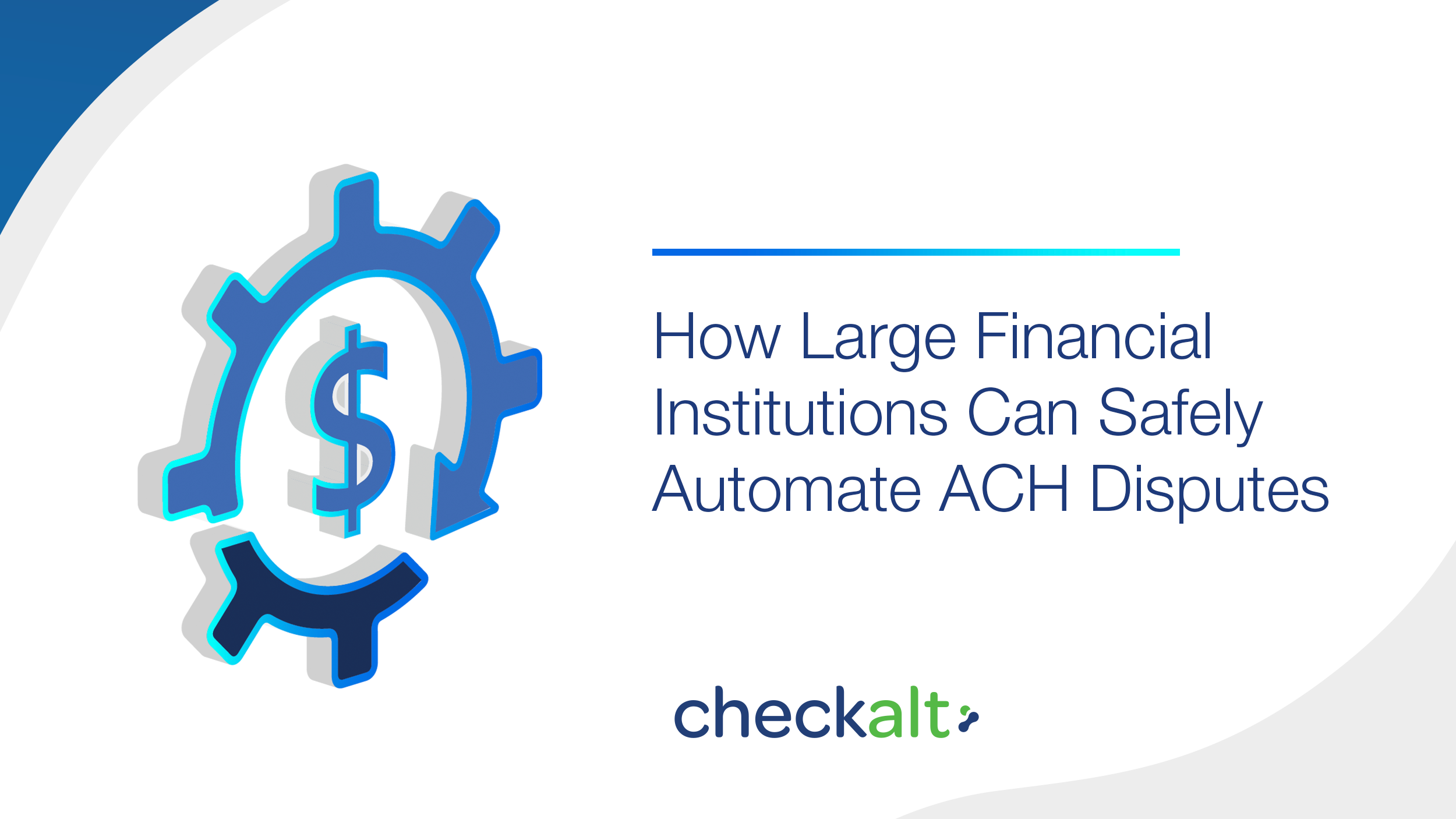Understanding Gen Z Banking Preferences: What Financial Institutions Can Do to Stay Relevant
With Gen Z gaining financial independence, banks and credit unions face a generational inflection point. These digital natives—born between 1996 and...
4 min read

Now that we have identified the root cause of the $96 million problem affecting financial institutions across the U.S., as noted in my previous article, let’s explore how Payment Case Manager (PCM) provides financial institutions with the ability to safely automate payment disputes.
If you have not already read the first article in this series, I encourage you to read that article now as it provides instructive background information on the root cause of the $96,000,000-per-year problem and how payment disputes can be remediated using PCM. It is instructive to understand how PCM would address the payment dispute “problem” differently for different institution types. While large FIs like Chase and small community banks and credit unions all participate in the same U.S. banking system, the issues and challenges they face in dealing with ACH disputes are vastly different. It is essentially a “Goldilocks” scenario where one institution receives too many and another institution receives too few. The issues are different, but both sized FIs exacerbate the “problem” equally. Let’s first examine how disputes affect large financial institutions.
Large Originating Depository FIs (ODFIs) have the business customers that originate the vast majority of ACH debits. If for no other reason than just their sheer size, they are the target of the most ACH dispute requests. Nearly every large ODFI also happens to be a large Receiving Depository FI (RDFI)—that is, they have many retail customers. For this reason, large FIs have issues regarding ACH disputes for both receiving disputes as well as originating disputes targeting another ODFI in the system. It not unusual for a large FI to receive many hundreds of ACH disputes, as an ODFI, via fax each business day. At the same time, as RDFIs, these large FIs are creating outbound dispute requests, again often numbering in the hundreds daily, that originate from their customer support center. Each case originated or received must be created, logged, tracked, followed up on, and ultimately remediated and closed. It is not hard to understand that the largest 25 U.S. debit originators bear a disproportionate amount of the $96 million problem.
Why PCM Works for Large FIs
- PCM supports all current ACH exception types, including those initiated by RDFIs to ODFIs:
• Request for Authorization.
• Late Return Request.
• Request for Originator Contact Information.
• Request for Converted Check Copy.
• Request for Additional Information on IAT (International ACH Transaction).
• Request for General Information from ODFI/Originator.
This helps large FIs two-fold. Large RDFIs can directly import cases from their customer or member support help desks to create cases. It also means that instead of receiving and manually processing faxes, an ODFI can directly act on each case to remediate it swiftly and at a greatly reduced expense.
Although not as common, the ODFI does also have the ability and need to send a request to an RDFI. PCM automates these requests, making it easy for ODFIs to import and automate the creating of these cases and for RDFIs to automate the remediation of the cases they receive. The cases initiated by ODFIs to RDFIs include:
• Request for Written Statement of Unauthorized Debit (WSUD).
• Request to Recall Transaction.
• Request for Payment Trace.
• Request for General Information from RDFI.
Here are some other benefits of PCM for large FIs:
- Cases can be imported from an RDFI’s client service or call center system, eliminating manual data entry of cases. Similarly, cases can be exported to any external system as needed.
- Automation allows FIs to identify and quickly remediate fraud.
- Workflow management enables cases to be allocated or reassigned across a geographically disbursed or virtual team.
- A supervisor dashboard enables management of overall case resolution and processing across a virtual team.
- Allows for most cases to flow between RDFI and Originator without ODFI operator intervention.
- ODFIs can customize automation controls including amount thresholds.
- Integration via single sign-on means that PCM can be integrated into existing FI internal intranet or to customer-facing cash management and treasury systems.
- Integration to fax service means manual inbound faxes can be converted into PCM cases. Similarly, outbound faxes to non-PCM member institutions can be automated.
- Integration is available for any third-party system, such as:
• ACH data repository
• ACH originator directory
According to industry estimates, the top 25 ACH debit originators either originate or are the target of 94% of all ACH dispute events. These institutions bear a disproportional portion of the $96 million cost. PCM features were intentionally designed to automate their processes and substantially reduce the costs associated with dispute resolution to only a small fraction of the cost they bear today. Let’s examine one sample scenario that illustrates how PCM would greatly reduce the cost of ACH disputes.
A large RDFI called 1st Bank has 120 potential unauthorized debits that are originated from the help desk or customer service center. These are imported into PCM and, after review, are delivered out to the various ODFIs. The savings for 1st Bank is 4 hours of manual work. One of those requests for authorization is targeting a large ODFI called National Bank. National Bank is a large ACH originator of debits and as such, gets many hundreds of ACH cases each day. The case from 1st Bank automatically is delivered to National Bank as both institutions are PCM users. In this example, National Bank’s customer is a company that originates ACH debits for a payment service called "HawkPay."
The authorization that 1st Bank wants is in the possession of HawkPay. PCM recognizes that HawkPay is the originator for this case and due to the settings enabled by National Bank in PCM, the case is immediately delivered to the “cases to be worked” PCM user interface at HawkPay. This eliminates the need for any employee at National Bank to examine the case. A HawkPay employee opens the case, sees the request from 1st Bank, accesses the documentation that exists within HawkPay’s network, and then attaches it to the case. HawkPay then submits the case back to National Bank. Again, due to the PCM settings at National Bank’s control, the case is identified as a completed case without further review and it is automatically returned to 1st Bank as a completed case.
This is just one small example of the way that PCM will drive down the cost of payment disputes. If the large FIs suffer millions of dollars in costs to manually address ACH disputes today, and PCM could eliminate 90-95% of that cost, what would that mean to gross margin improvement for these large FIs? Also consider that, at the same time they are greatly reducing their costs of disputes, they are automating the ability for the originating companies to address disputes as well. This represents a direct increase in customer satisfaction, a key driver for FIs regardless of size.
What about the remaining financial institutions? Even when the largest FIs are members of PCM, there would still be hundreds of monthly faxes for each large ODFI to address manually. Only by creating a network effect where all FIs can actively participate in PCM commensurate to their dispute task can the full positive impact of PCM be realized. The next article in this series will focus on how PCM addresses the “problem” from a small FI perspective.
RECENT BLOG POSTS:
• Combining Automation and Human-Driven Analysis to Keep More Payments Electronic

With Gen Z gaining financial independence, banks and credit unions face a generational inflection point. These digital natives—born between 1996 and...

ATM jackpotting is a threat to banks and credit unions in the United States. Here’s an updated guide on the risks and defenses for financial...

Commercial checks aren’t disappearing—but they are transforming. As digital payments become dominant, the role of checks is shrinking, shifting, and...